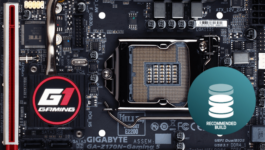Picking the best gaming PC is all about matching your own budget to the components on offer and what you actually need your new rig to do. Be honest with yourself, are you actually going to start that YouTube channel in 2024? Do you really need a high-performance, many-core CPU to deal with all the content creation you promised yourself you’d do when you bagged a new gaming PC? Or actually, do you just want the best frame rate bang for your buck, and actually need to prioritise on gaming performance over everything else?
You can spend a small—and sometimes not so small—fortune on unnecessary components when you could have bought a PC with higher actual gaming performance if you’d made the graphics card the focus. But that’s not to say that’s all you need to keep an eye on, because in my twenty-year tenure as a PC gaming tech journalist I’ve reviewed a lot of unbalanced machines and they rarely deliver over a more rounded spec. Below, I cover the specs you should expect at any given price point and also, given my experience testing PCs built by many different companies over the years, which gaming PCs I believe are the best for your budget. Right now, I think the ABS Cyclone Aqua is the best gaming PC for most people. It’s one of the most affordable RTX 4070-based systems we’ve seen, and still comes with a hefty amount of both RAM and storage. If that’s too rich for your blood the Yeyian Tumi is the best budget gaming PC. It’s a $750 RTX 4060 system, with a great overall component list to back that mid-range GPU up.
Testing every system at every configuration in the rich tapestry of gaming PCs is impossible. But we’ve had experience with all the main system builders’ work and have extensively tested the core parts in each. We are well-versed in identifying which is the best graphics card at each price point and the processor you’ll need to make the most of it. So whether you’ve got a tight $1,000 budget or are willing to spend up to $5,000 on your dream machine, we’ve got a great recommendation for the best gaming PC for you.

Dave James
Ever since building my first gaming PC as a teen I’ve been fascinated by their guts and have turned poking, prodding, and testing systems into a profession. Over the last 20 years or so I’ve tested hundreds of gaming PCs and have always been more interested in how a manufacturer squeezes the best parts and the best performance out of their budget. But I can’t lie, I do love an over-the-top big rig, too.
The quick list
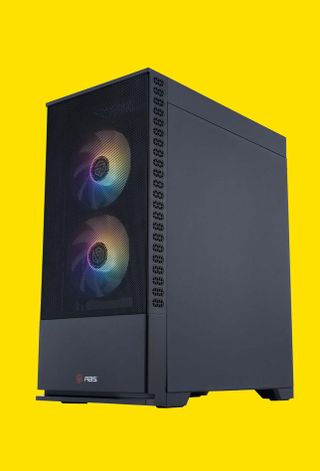
The best overall
Advanced Battlestations (ABS) is Newegg’s gaming subsidiary and actually produces some damned fine—and damned good value—gaming PCs. It’s systems we’ve personally tested have been well-specced and well packed for delivery, too. This particular machine comes with an outstanding spec for the money.

The best budget
This is a great price for a mid-tier gaming PC, especially when many rigs around this price might only deliver you an RTX 3060. The 12th Gen Core i5 is still a really solid CPU today, and the RTX 4060 is a good budget graphics card… just with the wrong name.

The best high-end
iBuyPower is one of the most established names in PC building, and its RDY line of gaming PCs and laptops means you can get a new rig in just a few days. This all-AMD system combines both the outstanding Ryzen 9 7950X3D and the RX 7900 XTX for a real high-end machine.
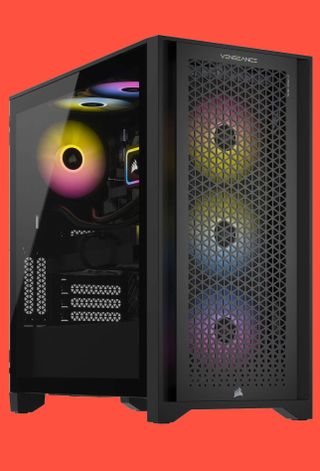
Ultra-enthusiast
Corsair makes almost every part of a modern gaming PC and knows how to put them together. With the best graphics cards at their hearts, and the finest CPUs, the Vengeance machines pull all that together with a surfeit of Corsair RAM and storage, and arguably the best chip coolers on the market.
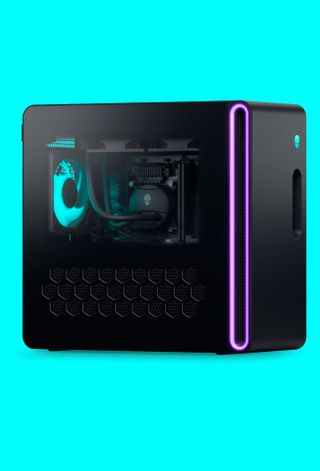
Don’t buy without a discount
Alienware is one of the most popular gaming PC manufacturers around, but the shine has slowly worn off for us as Dell’s corporate grip tightens. The Aurora machines still look beautiful, but the build quality has been lacking in recent years, and the value proposition all but non-existent. The bespoke components aren’t premium, and yet carry a premium cost.

6. Minsforum AtomMan G7 PT
The best mini PC
This is PC Gamer, so the best mini PC needs to be able to do that, and with the discrete RX 7600M XT inside it, the AtomMan G7 PT is absolutely capable of delivering on that front. Its eight-core, 16-thread Zen 4 chip is also equally capable of any productivity goodness, too.
Updated October 3, 2024 to change the primary recommendation to reflect the best-value gaming PC you can buy right now and include our pick for the best mini PC, too. You can now check out both our criteria for picking the best gaming PCs, as well as some handy advice for how to pick what machine is best for you.
The best gaming PC $1,000 – $2,000
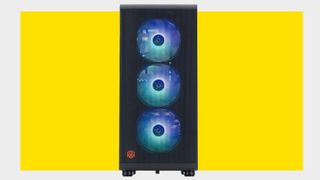

ABS is Newegg’s gaming PC subsidiary and as such comes with a wealth of history and expertise behind it. And that’s shone through in the machines we’ve tested ourselves, which have offered both great specs and great value. And there are almost always offers available on ABS systems, too, which makes them a great shout when you’re looking for a bargain buy. Like a lot of the other builders, though, I’d prefer better than a one year warranty as standard, but that’s my only real issue.
Buy if…
✅ You want to hit 1440p frame rates: The RTX 4070 is able to nail excellent 1080p numbers, but you will also be able to power a 1440p gaming monitor to an impressive extent, especially with DLSS 3.0 and Frame Generation.
✅ You want a ton of RAM: There’s nothing in this system that screams ‘upgrade me!’ and the 32GB of fast DDR5 will see you right for the lifetime of your rig.
✅ You want seriously secure shipping: The ABS rigs we’ve tested have come so well packaged that it’s almost overkill. But a safe PC is a worthy investment in recycled packaging.
Don’t buy if:
❌ You need high-end productivity: The Core i5 13400F is a gaming chip first and foremost. It does have six full performance cores, but it’s not a productivity beast. It’s certainly no slouch, and has decent multithreaded performance, but it is primarily a gaming chip.
The $1,000 to $2,000 price point is arguably the most important one for PC gaming; this is where the majority of PC gamers will be aiming to spend their budget and for us that’s where the best gaming PC really lives. It’s a crowded market, but the positive part of that is there are a lot of options to choose from. But this is where it’s no longer okay to be going with a last-gen graphics card, because the RTX 4070, RTX 4070 Super, and RTX 4070 Ti have now launched and are the best GPUs around this price point.
With RTX 3080 performance from the RTX 4070, and systems on sale for under the $1,200 mark with the Nvidia GPU inside it, there’s no longer a case to be made for RTX 3080 or RX 6800 XT machines that cost more. And they generally do. The RTX 4070 Ti and RTX 4070 Ti Super, which you’ll find just below the top end of the $2,000 budget, offer RTX 3090-level gaming performance, and considering that was a $1,500 graphics card of the last generation which you’d never find close to this price.
I don’t think you need to worry so much about last-gen CPUs, as 12th Gen Intel and AMD Ryzen 5000-series CPUs will still carry an RTX 4070 Ti in gaming terms, but that will limit you in terms of memory. The latest generations from both chip makers come with DDR5 memory, which is much quicker for actual memory intensive productivity tasks. You should also not consider less than 1TB of SSD storage, and ideally 2TB at today’s prices.
The specs to expect in a gaming PC between $1,000 and $2,000:
- Graphics card: Nvidia RTX 4070 | RTX 4070 Super | RTX 4070 Ti | RTX 4070 Ti Super
- CPU: Intel Gen Core i7 12th Gen | 13th Gen | 14th Gen | AMD Ryzen 7 5000-series | 7000-series
- Memory: 16GB or 32GB DDR5
- SSD: 1TB PCIe
- PSU: 700W+
The best alternatives:
The best gaming PC around $1,000 or less
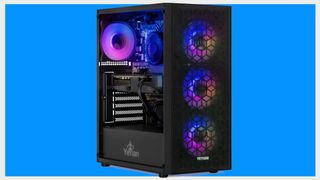
2. Best budget gaming PC: Yeyian Yumi

Yeyian is a California-based gaming PC builder that’s been around for the last five years. But, I’ll be honest, when I first came across its rigs on US retailers I foolishly presumed it was a brand shipping units in from outside North America. We’ve seen it providing both well-specced budget gaming PCs at heavy discounts around sales events, as well as high-end machines coming out with the latest and greatest hardware, too. More importantly it has a pretty good basic warranty, offering three years labor, two years parts, and one year’s shipping, as well as lifetime tech support.
Buy if…
✅ You’re just after a pure gaming PC: That RTX 4060 will deliver excellent 1080p frame rates and good 1440p numbers, too.
✅ $1,000 is your limit: At well under $1,000 the Yeyian gives you a bit of breathing room when it comes to your budget.
Don’t buy if:
❌ You need raw CPU power: The Core i5 12400F is a decent gaming CPU, but its six cores won’t deliver much in the way of processing power for streaming or content creation.
❌ You really want to push that budget: There are RTX 4060 Ti gaming rigs just under the $1,000 mark if you’re happy going to the very top of your budget.
When you’re looking for a gaming PC under $1,000 then it’s all about the spec and the price, regardless of who or where it’s from. Well, within reason. So long as the company you’re purchasing from has actually successfully sold gaming PCs before, and doesn’t have a host of poor reviews, you just want to make sure you’re getting the parts you would hope for at this price point.
At the moment that would ideally be an RTX 3060 Ti, which was one of the best graphics cards of the last generation. It’s a powerful GPU, not that far off an RTX 3070, and still has no equivalent from within the new generation of AMD and Nvidia cards. But given the RTX 4070 has now dropped, we are expecting an RTX 4060 Ti soon. But that should mean prices on the RTX 30-series should keep dropping with abundant stock. There are still a lot of RTX 3060 GPUs out there, however, so if you can bag a PC with one of those for $700 or less you’re doing well.
Alongside that you’ll want either a Core i5 or Ryzen 5 processor, but anything from the Intel 11th Gen or AMD 5000-series will be more than enough, and 16GB of RAM. You’ll probably only find a ~500GB SSD in these builds, but that’s the most affordable upgrade down the line.
The specs to expect in a gaming PC under $1,000:
- Graphics card: Nvidia RTX 4060 | RTX 4060 Ti | Radeon RX 7600
- CPU: Intel Gen Core i5 12th Gen | AMD Ryzen 5000-series
- Memory: 16GB DDR4-3200
- SSD: 1TB PCIe
- PSU: 500W
The best alternatives:
The best gaming PC $2,000 – $3,000
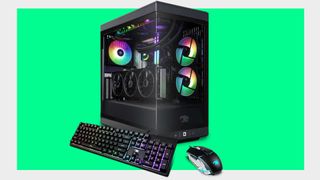

iBuyPower
iBuyPower is a classic name in PC building, and has a whole lot of history when it comes to making machines. We’ve checked out a number of them ourselves, and while they’re not always the most exciting-looking rigs (though the one above actuallly is), they’re always well built and well put together. And, if you’re after a new gaming PC quickly, these RDY PCs don’t have the extra customizations of its more bespoke builds, but will ship in a couple of days.
Buy if…
✅ You want a smart, clean PC: iBuyPower isn’t always the most exciting of builders, but the chassis it’s used here makes the PC look great.
✅ You want it fast: Speedy delivery on iBuyPower machines means you should get your new PC in around three days.
✅ You want to go AMD: This all-AMD rig delivers the best the red team has to offer all in one impressively affordable package.
Don’t buy if:
❌ You’re super into ray tracing: The Radeon RX 7900 XTX is a great straight raster gaming GPU, but it’s not the finest graphics card when it comes to running the latest ray traced gaming pretties.
When you’re getting to the rarified heights of the $2,000 – $3,000 price point you’re really getting into the elite of gaming PC systems. This is where you can start to pull in some really high spec components. Given that you can get RTX 4070 Ti gaming PCs for less than two grand, you really ought to be targeting either the RTX 4080 or the AMD Radeon RX 7900 XTX at this level.
You can also start to think about high-end CPUs here, too, with Core i7 and Ryzen 7, even Ryzen 9 chips all available within this price range. And that means you’re looking at PCs that won’t just be fantastic gaming systems, but with effectively workstation-level computational power, too. In this market you should be looking at systems that will make excellent creator machines.
You will arguably see PCs with very similar specs lists at this price point, which means your choice of machine often comes down to secondary considerations, such as shipping time, which brand of components are being used, and such things as warranties and returns. We like iBuyPower RDY machines because of their rapid turnaround from sales which could see you ordering a new rig on Monday and be gaming by Wednesday evening. I also like Corsair’s Vengeance machines, because it makes excellent, reliable chassis, SSDs, memory, and cooling itself. Which means it can put high-end supporting parts in your new PC.
This is also where you want to be able to trust the system builders more than just taking a punt on saving $100 on a similar spec, but from a brand you maybe don’t know so well.
The specs to expect in a gaming PC between $2,000 and $3,000:
- Graphics card: Nvidia RTX 4080 | AMD Radeon RX 7900 XT/XTX
- CPU: Intel Gen Core i7 12th Gen | 13th Gen | AMD Ryzen 7 5000-series | 7000-series
- Memory: 32GB DDR5-5600
- SSD: 2TB PCIe
- PSU: 850W+
The best alternatives:
The best gaming PC $3,000 – $5,000
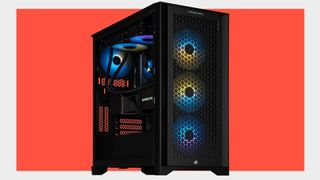

Corsair has been quietly—and sometimes not so quietly—making some of the best PC parts for years, with only the core componentry of GPUs, CPUs, and motherboards a place it hasn’t touched. So, with the best PC cases around, it stands to reason they would make some great full systems. Again, the use of standard components makes upgrading down the line easier, and as it’s Corsair you’re getting some of the best memory and power supplies around, too. They do generally come in a lot more expensive than the competition, but at this level you really do pay for what you get.
Buy if…
✅ You want the best CPU/GPU combo around: The Corsair machine comes with the best Intel processor and Nvidia graphics card, but doesn’t surround it with unnecessary extras simply to hike up the price.
✅ You want a cool and quiet rig: The chassis and cooler combo means you’re getting an setup that’s able to keep those high-end components running at top speed without getting too shouty. We love the black monolith of a chassis, and Corsair’s AIO coolers are some of the best.
Don’t buy if:
❌ You want a statement piece: This isn’t some fully water-cooled setup, with hard tubing and multiple radiators, and RGB’d to within an inch of its life. Those can be gorgeous machines, great for a tradeshow floor, but you’re paying for a tubed setup that locks you out of system upgrades down the road.
Although $5,000 is a lot of money to spend on a gaming PC, this isn’t money-no-object territory and you still want to make sure you’re getting the performance you’re paying for. That means making sure you’re not spending over the odds on useless extras thrown into a build just to hike up the price to make it seem more ‘premium’ than it really is.
What this budget does mean, though, is you getting your hands on the finest gaming graphics card ever made by humankind. The RTX 4090 is the top of the stack, and the only GPU from Nvidia’s RTX 40-series that really does feel like a whole new generation of graphics silicon. It’s expensive, but it’s genuinely delivering gaming performance you can’t get anywhere else.
What you then need to decide is whether you want to go AMD or Intel for the supporting cast. The Intel 13th Gen Core i9 chips are excellent gaming processors, and deliver a huge amount of multi-threaded performance for any kind of productivity workload you’d care to throw its way. But, on the flip side, the Ryzen 9 7950X3D delivers the highest potential gaming performance you can get from a CPU thanks to its 3D V-cache chiplet.
That extra cache will mean your high-end GPU has the best chance to shine, and the 16 full cores of Zen 4 processing means you still get workstation-level productivity chops, too. All that said, there are really only a few frame per second in it between the Intel and AMD options when you’re talking about the sorts of high resolutions you’re going to be pushing the RTX 4090 through.
When you’re spending this much you could consider going all out on a full closed-loop liquid cooling array. Such systems look spectacular, and genuinely give off that dream machine vibe. Though how effective such arrays are is more debatable. If you’re spending big on a system because you want someone else to build you a top-end rig and don’t ever want to touch it, such a rig would be great. But if you ever want to get involved with upgrading your core components a closed loop is a real pain in the butt to maintain. Given the diminishing returns of overclocking modern components, such extreme cooling is also not entirely necessary, either.
The specs to expect in a gaming PC between $3,000 and $5,000:
- Graphics card: Nvidia RTX 4090
- CPU: Intel Core i9 13900K/F | AMD Ryzen 9 7950X/3D
- Memory: 32GB DDR5-5600 minimum
- SSD: 2TB SSD
- PSU: 1KW
The best alternatives:
Alienware
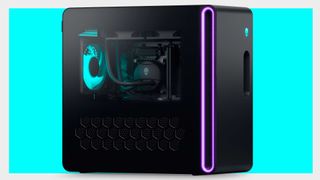

When I was a whelp I used to hanker after Alienware PCs and laptops, but as I’ve gotten older, so Alienware has changed. It’s become more and more like its corporate Dell overlord, and far less tantalising a prospect. My biggest issue is the use of proprietary components, which would be fine if they were the finest, and beyond reproach, but you will find other equivalently priced builds with superior motherboards and power supplies that you can also upgrade in the future. And price is definitely an issue, too, with the Alienware premium not really buying you anything tangible for the extra. I will reiterate my mantra, never buy a full price Alienware, because they only become worthwhile with a hefty discount.
Buy if…
✅ You just want plug and play: Alienware machines will just work out of the box and with the might of Dell behind it you can be relatively confident that you’ll be looked after if something goes awry.
✅ You’re into the aesthetic: Alienware rigs look good, and unlike any other machine on this list. The curvy chassis are a world away from the boxy towers otherwise used. But they certainly are big…
Don’t buy if…
❌ You want peak performance: We’ve not had great experiences with recent Alienware machines delivering the performance their parts ought to. That’s often down to the bespoke nature of the components and sometimes ineffective cooling.
❌ You want to upgrade your PC in the future: No PC is truly future proof, no matter how much you spend, so either you upgrade your rig, or you buy a new one. With Alienware, you’re largely locked into the latter by its use of bespoke motherboards, chassis, and PSUs.
❌ You want value for money: The deal above is a rarity for Alienware PCs. More often than not you’ll be paying well over the odds for a machine that performs notably worse than an equivalently priced system from pretty much anyone else.
Alienware is one of the biggest names in gaming PCs, with a heritage stretching back to the dawn of time. Well, 1996 anyway. With a penchant for stylish designs and high-performance hardware it cemented its place in the burgeoning sphere of gaming-focused PCs. In 2006 it was bought wholesale by corporate PC giant, Dell, and that helped bring an economy of scale to the brand that previously it didn’t have access to.
But that hasn’t necessarily meant those economies of scale have been passed on to the consumer, as Alienware has always kept itself as a premium tier brand within the Dell portfolio. Which was fine when it was offering a premium experience to the people who bought its PCs.
For years we have had Alienware on the top of our best gaming PC lists, because historically its systems could be relied upon to deliver a top-tier experience and premium performance. In recent times, however, we’ve reviewed different Alienware gaming PCs and have found they fall short of our expectations. Given some performance issues, cooling problems, and concerns around bespoke components, we would categorically say you shouldn’t buy a full price Alienware PC and only look to pick one up when they are heavily discounted.
The bespoke components used inside them sometimes fall short of the sort of performance you’ll get out of motherboards, coolers, and power supplies you can buy from other named brands, such as Corsair, Asus, or MSI. They are also generally designed specifically for use exclusively inside Alienware’s own chassis, which means those cases don’t allow for third-party upgrades down the line. At least not without some serious modifications. At best that locks you into the Alienware/Dell ecosystem of high-priced hardware, and at worst locks you out of upgrading your expensive rig at all in the future.
The best mini PC
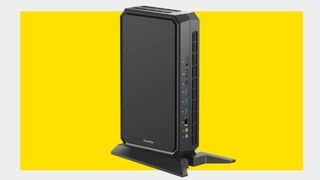

If you’re after a mini PC that can also game, then Minisforum is one of the best outfits for that. It’s Venus UM790 Pro is an outstanding micro machine, that’s our favorite budget mini PC, but if you want something with more grunt the AtomMan G7 PT is an absolute winner. More than the components it chooses, it’s the impressive cooling capacity of Minisforum machines that means they get our vote as the best mini PC. Many small form factor PCs will suffer from egregious sound levels, but Minisforum’s cooling chops means it can keep even a discrete GPU chilled enough not to whine in a smaller chassis.
Buy if…
✅ You’re after high performance in a tiny footprint: The combination of 16-core Ryzen CPU and RX 7600M XT discrete GPU makes this a powerful computational beast as well as a decent, tiny 1080p gaming rig.
Don’t buy if…
❌ You want a PC that will grow with you: There’s no real upgrade path when both the CPU and GPU are soldered onto the board and non-replaceable.
❌ You want more than 1080p gaming: With the best will in the world, the RX 7600M XT is not a GPU that will be comfortable at 1440p or 4K resolutions in-game.
The Minisforum AtomMan G7 PT is our pick as the best mini PC for gaming, simply because it comes in a tiny form factor, with excellent cooling, and a seriously impressive CPU and GPU combo. Packing the 16-core AMD Ryzen 9 7945HX means that you get stellar levels of processing power, making it an eminently portable workstation.
But for us, it’s the inclusion of the Radeon RX 7600M XT (yes, it’s all AMD here) that tips this system over the edge of standard mini PC-dom and into the realms of gaming PCs. Sure, you’re not going to get the same sort of gaming performance as you’ll see in the hyper-expensive Asus ROG NUC with its mobile RTX 4070, but it’s also cooler and quieter for it.
You’re still getting mighty 1080p gaming performance from the AMD GPU, and way beyond what you’ll see from any integrated GPU you could mention.
The AtomMan G7 PT is potentially the most PC Gamer of all the mini PCs we’ve tested in recent times, and that’s because of its gaming prowess and barebones nature. You can pick it up with 32 GB of DDR5 and a 1 TB SSD with Windows on it, and that is the straightforward choice, but if you wanted to go rogue and slap 96 GB of DDR5-5200 in there you could. You could also go with two separate SSDs, too, as it ships with both PCIe 5 and PCIe 4 M.2 sockets.
Read our full Minisforum AtomMan G7 PT review.
The best alternatives:
How we test gaming PCs
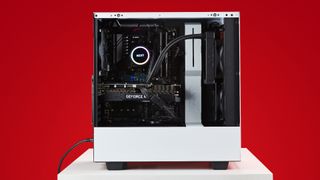
We spend a lot of time testing gaming PCs to ensure that we know what sort of experience you would get should you spend your hard earned cash on one. Experience is an important factor—you want to know that pulling your new rig from its box that it’s going to work as soon as you plug it in, and let you get up and gaming as soon as you can download your favourite games.
But the general feel of using a PC is one part of it, it’s also important to get the relative performance numbers to be able to see how a given machine performs in games compared with other systems. We run a selection of benchmarks to gauge CPU performance, storage performance, and of course gaming performance.
We are now using Cinebench R23 and X264 to test the processor’s rendering and encoding capabilities—which will tell you both how good the CPU is, as well as how good its cooling is—and Final Fantasy XIV Shadowbringers and 3DMark to test the storage inside a PC. For the gaming side, we use 3DMark Time Spy, Hitman 3, Metro Exodus Enhanced Edition, F1 22, Far Cry 6 and Warhammer III to give us 1440p frame rate metrics.
We will get inside the machine to see how well built it is, and how well the builder has tidied up the mass of cabling that always lurks inside a gaming PC. It’s also important to know how much of an upgrade path a system might have, whether there is space inside for a extra storage, or more memory, etc.
Value is also a key concern for us. A gaming PC represents a large outlay, and no matter whether it’s a $900 or a $5,000 machine, it still needs to be able to justify its cost by the quality of the build and the components inside it.
Check out how we test all PC gaming hardware.
Selection criteria
Our selection criteria for picking the best gaming PC comes down to the brands we’ve used and have had good experience with, and the ones who consistently put together good-value, well-specced machines.
It’s not possible to review every single gaming PC on sale, but we have tested PCs from all the major manufacturers, and have experienced the unboxing and shipping processes they use.
But the biggest thing is always going to be the mix of core configuration and the overall price. If there’s a machine with a great GPU and CPU combination, but is priced well beyond the competition then it’s not going to get the nod from us. Equally if a PC maker consistently pairs its gaming PCs with single channel memory (*cough*Alienware*cough*) or reliably sticks 512 GB SSDs in with $1,500 systems, they’re not going to get a recommendation from us, either.
How to choose a gaming PC
As a PC gamer your primary point of reference for picking your new gaming PC should be around what graphics card it has inside it. That is the key component when it comes to getting the highest frame rates for your games and is the first decision you must make… once you know what budget you have to work with.
Check out our list of the best graphics cards for a run down of the current state of the GPU market, but we’ve also got our graphics card hierarchy list below where you can see in a quick snap-shot just how they perform against each other.
Once you’ve got your GPU picked, then it’s about finding the best-value gaming PC sporting that graphics card. And, as I said before, you want to make sure you get a balanced PC for all that you might want to focus on the GPU at its heart. You need to have a processor that can keep your graphics card fed with data, and memory enough that your system doesn’t collapse under a weight of Chrome tabs.
The minimum we would recommend on the memory front today would be 16 GB, but we would also suggest making sure that comes in two separate sticks (often denoted for a 16 GB kit as 2x 8 GB). That ensures you get the highest memory bandwidth possible from so-called dual-channel memory. With a single stick of memory you will only get half that bandwidth.
While you do need to have a processor, or CPU, that’s able to keep your GPU running at optimal pace, that doesn’t mean you need to have a million cores to do it. Unless you’re engaging in a lot of video editing or 3D graphics work, a CPU with six or eight cores will absolutely be enough for a gaming PC. Don’t be desperate to bag a 16-core chip if all you’re going to be doing is playing games. We’ve picked the best CPUs for gaming from the current chips available, so it’s worth checking out any build you’re interested in against that list.
Finally, storage. This is an area where a lot of system integrators cheap out on, and with games taking up an inordinate amount of capacity today it’s worth making sure you’re set from the off. The minimum today—unless it’s a super bargain rig—should be a 1 TB SSD. It is the easiest upgrade, but one you don’t want to have to be doing as soon as you set up Steam on a new machine.
GPU hierarchy: How do the GPUs stack up?
The most important component for any gaming PC build will always be the graphics card. That will give you the best idea about how one machine matches up with another just in terms of raw gaming performance.
Below, we’ve listed the slew of GPUs we’ve had over the past couple of years listed in terms of their Time Spy Extreme index score as a way to put them in some consistent hierarchy. This doesn’t cover the performance difference between graphics card in every instance, as differences in how they handle ray tracing other graphical effects can play a part. But this is a handy one-shot method of getting a rough idea of how the various cards from these various generations of GPU stack up against each other.
Gaming PC reviews
Gaming PC FAQ
Why buy a prebuilt gaming PC?
One of the most significant advantages of building your PC is the ability to hand-pick every single component in the system. This enables you to take your time shopping around for deals and finding the best combination of parts to fit your budget and performance needs. The downside for most inexperienced builders is that this process can take some time and cause quite a headache if something goes wrong. You only get warranties on the individual components, not your finished build, and this is where the best prebuilt gaming PCs shine.
What do you get for your money in a prebuilt PC?
When you pay the premium to configure or purchase a prebuilt PC, you pay for more than just the parts. You pay for warranty service, support, and peace of mind that professionals put your system together. These are some of the things we value highly when considering what the best gaming PC is. We also look at other selling points, like design, upgradability, and anything you wouldn’t be able to do when building it yourself.
What sets a prebuilt machine apart from a DIY build?
One of the most significant factors that make PCs stand apart from the competition is the design. Prebuilt systems like the Alienware Aurora R10 or Corsair One use unique in-house chassis designs you wouldn’t be able to purchase when building it yourself. You can take some comfort in knowing that these systems were designed and built specially to house your configuration, though that can make upgrading more awkward later on down the line.
When we set out to choose our top choices of prebuilt gaming PCs, we look at almost every major manufacturer and system integrator to find the best combination of value, reliability, customer feedback, design, and performance for various budgets and needs.
